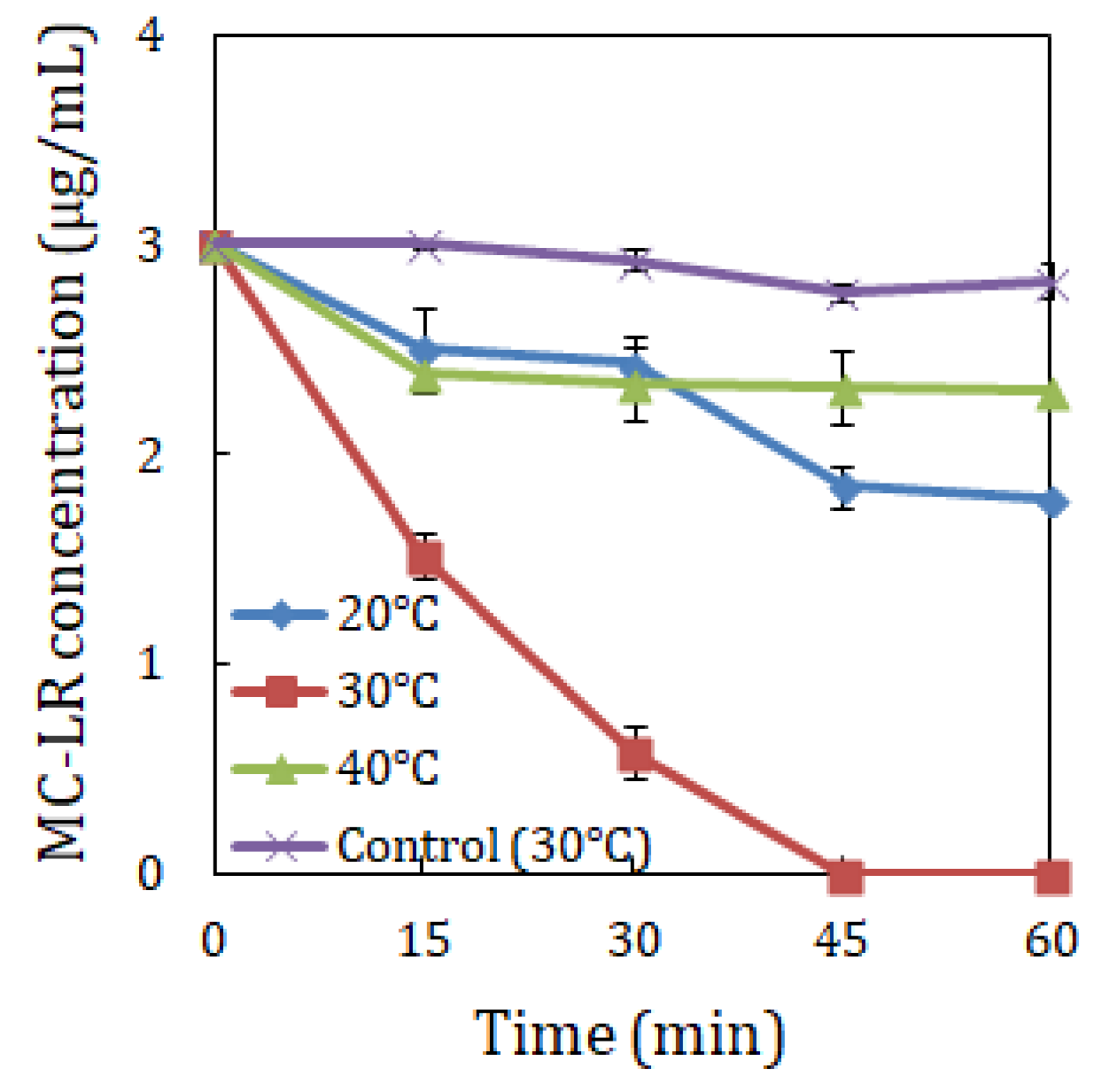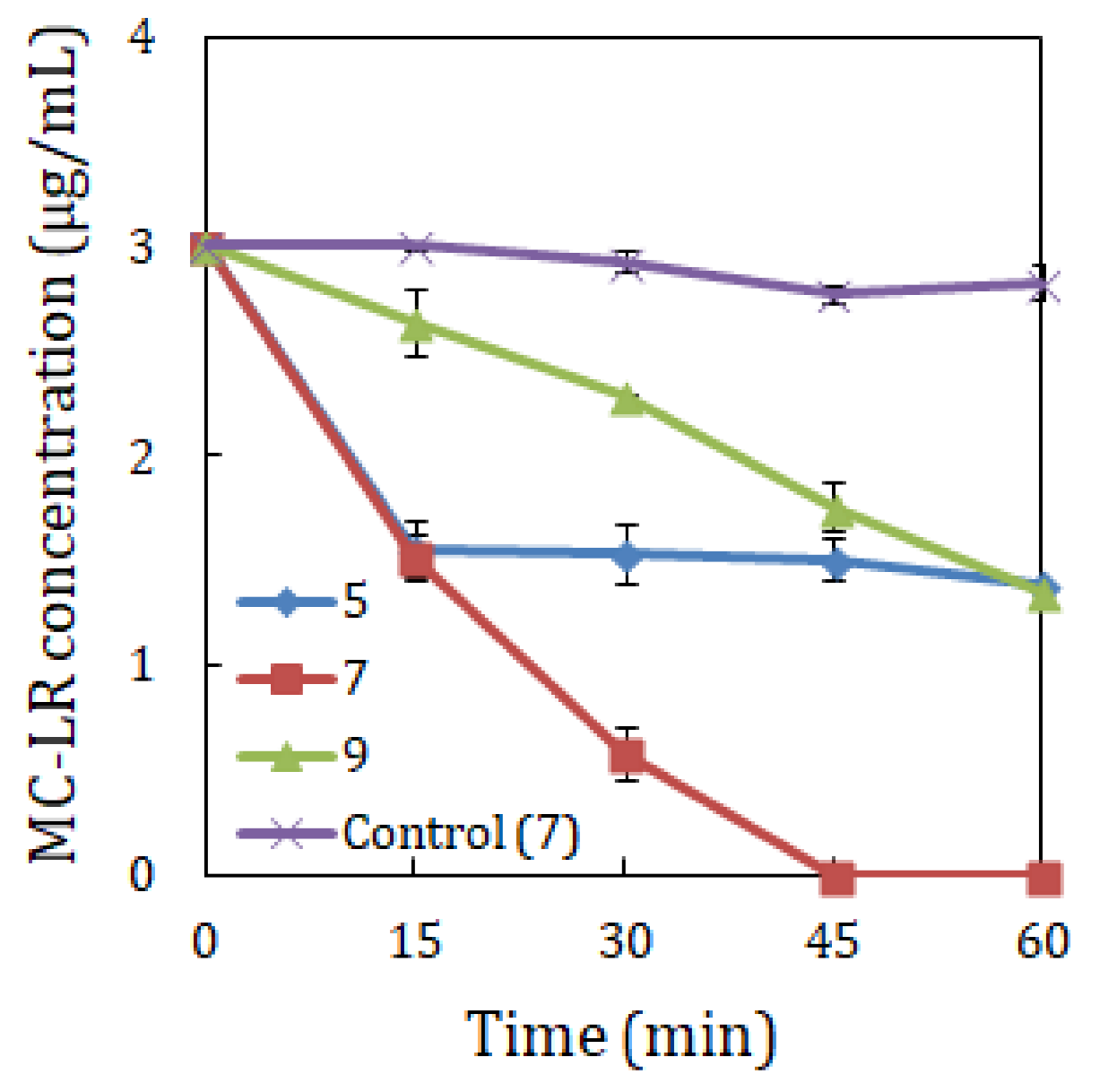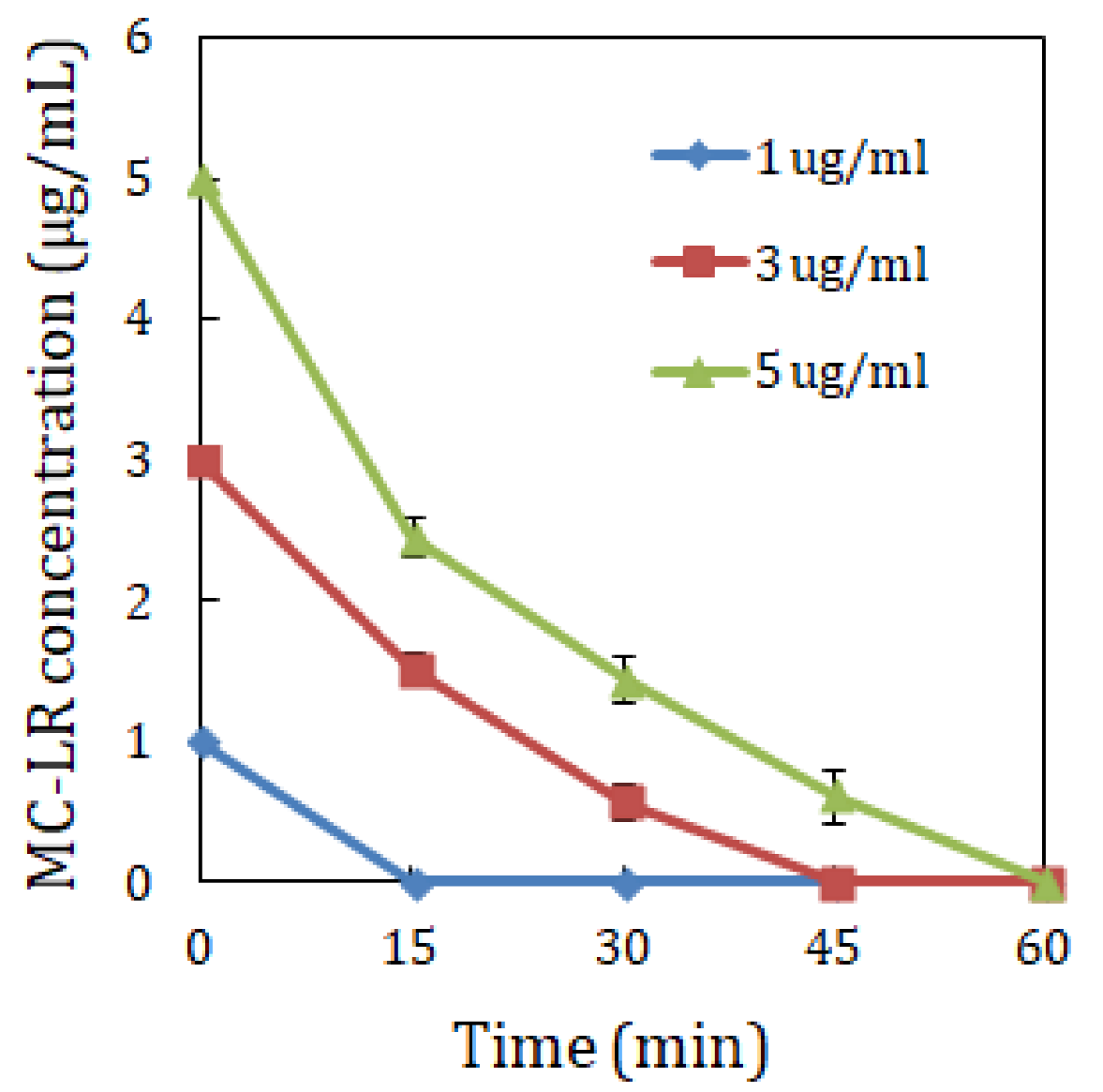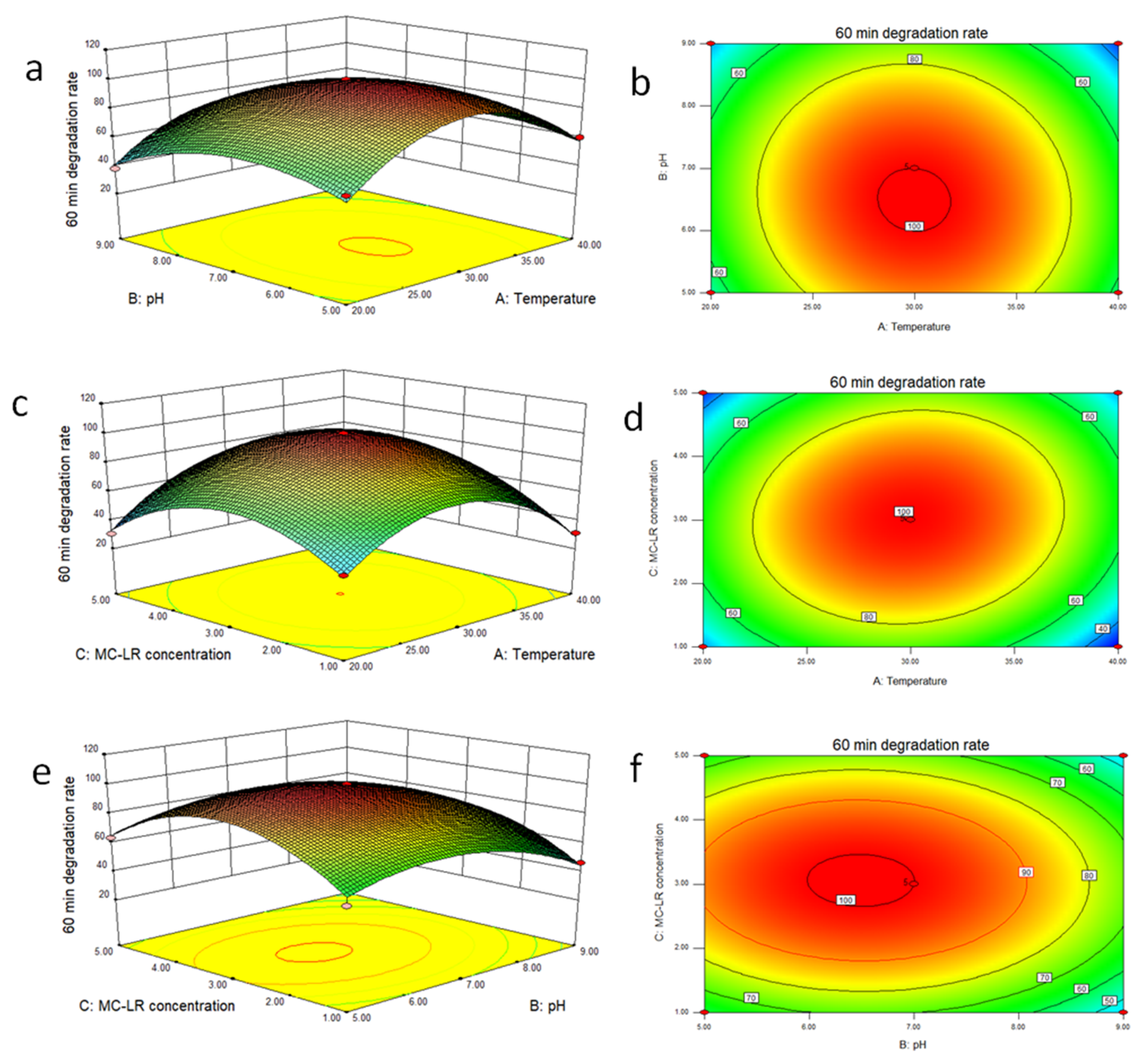Optimization of Biodegradation Characteristics of Sphingopyxis sp. YF1 against Crude Microcystin-LR Using Response Surface Methodology
Abstract
:1. Introduction
2. Results and discussion
2.1. Crude MC-LR Biodegrading Characteristics under Varying Environmental Factors Using Strain YF1
2.2. Response Surface Methodology for Environmental Factor Selection and Analysis
2.3. Interactive Effects of Multiple Environmental Factors on Crude MC-LR Biodegradation by Strain YF1
3. Conclusions
4. Materials and Methods
4.1. Materials and Reagents
4.2. Extraction of MC-LR
4.3. Isolation of Bacterial Strain
4.4. Crude MC-LR Biodegradation by Strain YF1
4.5. Analysis of Crude MC-LR
4.6. Response Surface Method Design for Optimizing the Environmental Factors
Supplementary Materials
Author Contributions
Funding
Institutional Review Board Statement
Informed Consent Statement
Data Availability Statement
Conflicts of Interest
References
- Massey, I.Y.; Al osman, M.; Yang, F. An overview on cyanobacterial blooms and toxins production: Their occurrence and influencing factors. Toxin Rev. 2020, 1–21. [Google Scholar] [CrossRef]
- Huisman, J.; Codd, G.A.; Paerl, H.W.; Ibelings, B.W.; Verspagen, J.M.H.; Visser, P.M. Cyanobacterial blooms. Nat. Rev. Microbiol. 2018, 16, 471–483. [Google Scholar] [CrossRef] [PubMed]
- Svirčev, Z.; Lalić, D.; Savić, G.B.; Tokodi, N.; Backović, D.D.; Chen, L.; Meriluoto, J.; Codd, G.A. Global geographical and historical overview of cyanotoxin distribution and cyanobacterial poisonings. Arch. Toxicol. 2019, 93, 2429–2481. [Google Scholar] [CrossRef] [PubMed]
- Zhang, X.-J.; Chen, C.; Ding, J.-Q.; Hou, A.; Li, Y.; Niu, Z.-B.; Su, X.-Y.; Xu, Y.-J.; Laws, E.A. The 2007 water crisis in Wuxi, China: Analysis of the origin. J. Hazard. Mater. 2010, 182, 130–135. [Google Scholar] [CrossRef]
- Massey, I.Y.; Zhang, X.; Yang, F. Importance of bacterial biodegradation and detoxification processes of microcystins for environmental health. J. Toxicol. Environ. Health Part B 2018, 21, 357–369. [Google Scholar] [CrossRef]
- Bouaïcha, N.; Miles, C.; Beach, D.; Labidi, Z.; Djabri, A.; Benayache, N.; Nguyen-Quang, T. Structural Diversity, Characterization and Toxicology of Microcystins. Toxins 2019, 11, 714. [Google Scholar] [CrossRef] [Green Version]
- Yang, F.; Huang, F.; Feng, H.; Wei, J.; Massey, I.Y.; Liang, G.; Zhang, F.; Yin, L.; Kacew, S.; Zhang, X.; et al. A complete route for biodegradation of potentially carcinogenic cyanotoxin microcystin-LR in a novel indigenous bacterium. Water Res. 2020, 174, 115638. [Google Scholar] [CrossRef]
- You, D.J.; Chen, X.G.; Xiang, H.Y.; Ouyang, L.; Yang, B. Isolation, identification and characterization of a microcystin-degrading bacterium Paucibacter sp. strain CH. Huan Jing Ke Xue 2014, 35, 313–318. [Google Scholar]
- Ding, Q.; Liu, K.; Xu, K.; Sun, R.; Zhang, J.; Yin, L.; Pu, Y. Further Understanding of Degradation Pathways of Microcystin-LR by an Indigenous Sphingopyxis sp. in Environmentally Relevant Pollution Concentrations. Toxins 2018, 10, 536. [Google Scholar] [CrossRef] [Green Version]
- Azevedo, S.M.F.O.; Carmichael, W.W.; Jochimsen, E.M.; Rinehart, K.L.; Lau, S.; Shaw, G.R.; Eaglesham, G.K. Human intoxication by microcystins during renal dialysis treatment in Caruaru—Brazil. Toxicology 2002, 181, 441–446. [Google Scholar] [CrossRef]
- Davison, D. Cyanobacteria: Ecological Importance, Biotechnological Uses and Risk Management; Nova Science Pub Inc.: Hauppauge, NY, USA, 2014; 192p. [Google Scholar]
- Cao, L.; Massey, I.Y.; Feng, H.; Yang, F. A Review of Cardiovascular Toxicity of Microcystins. Toxins 2019, 11, 507. [Google Scholar] [CrossRef] [PubMed] [Green Version]
- Yi, X.; Xu, S.; Huang, F.; Wen, C.; Zheng, S.; Feng, H.; Guo, J.; Chen, J.; Feng, X.; Yang, A.F. Effects of Chronic Exposure to Microcystin-LR on Kidney in Mice. Int. J. Environ. Res. Public Health 2019, 16, 5030. [Google Scholar] [CrossRef] [PubMed] [Green Version]
- McLellan, N.L.; Manderville, R.A. Toxic mechanisms of microcystins in mammals. Toxicol. Res. 2017, 6, 391–405. [Google Scholar] [CrossRef] [PubMed] [Green Version]
- MacKintosh, C.; Beattie, K.A.; Klumpp, S.; Cohen, P.; Codd, G.A. Cyanobacterial microcystin-LR is a potent and specific inhibitor of protein phosphatases 1 and 2A from both mammals and higher plants. FEBS Lett. 1990, 264, 187–192. [Google Scholar] [CrossRef] [Green Version]
- Zhou, M.; Tu, W.-W.; Xu, J. Mechanisms of microcystin-LR-induced cytoskeletal disruption in animal cells. Toxicon 2015, 101, 92–100. [Google Scholar] [CrossRef]
- IARC. Ingested Nitrate and Nitrite, and Cyanobacterial Peptide Toxins; World Health Organization, International Agency for Research on Cancer: Lyon, France, 2010. [Google Scholar]
- WHO. Cyanobacterial Toxins: Microcystin-LR. Guidelines for Drinking Water Quality; World Health Organization: Geneva, Switzerland, 1998. [Google Scholar]
- WHO. Coastal and Fresh Waters, Guidelines for Safe Recreational Water Environments; World Health Organization: Geneva, Switzerland, 2003. [Google Scholar]
- He, X.; Liu, Y.-L.; Conklin, A.; Westrick, J.; Weavers, L.K.; Dionysiou, D.D.; Lenhart, J.J.; Mouser, P.J.; Szlag, D.; Walker, H.W. Toxic cyanobacteria and drinking water: Impacts, detection, and treatment. Harmful Algae 2016, 54, 174–193. [Google Scholar] [CrossRef]
- Svrcek, C.; Smith, D.W. Cyanobacteria toxins and the current state of knowledge on water treatment options: A review. J. Environ. Eng. Sci. 2004, 3, 155–185. [Google Scholar] [CrossRef]
- Massey, I.Y.; Yang, F. A Mini Review on Microcystins and Bacterial Degradation. Toxins 2020, 12, 268. [Google Scholar] [CrossRef] [Green Version]
- Jing, W.; Sui, G.; Liu, S. Characteristics of a Microcystin-LR Biodegrading Bacterial Isolate: Ochrobactrum sp. FDT5. Bull. Environ. Contam. Toxicol. 2013, 92, 119–122. [Google Scholar] [CrossRef]
- Yang, F.; Zhou, Y.; Yin, L.; Zhu, G.; Liang, G.; Pu, Y. Microcystin-Degrading Activity of an Indigenous Bacterial Strain Stenotrophomonas acidaminiphila MC-LTH2 Isolated from Lake Taihu. PLoS ONE 2014, 9, e86216. [Google Scholar] [CrossRef] [Green Version]
- Zhang, Y.; Wei, H.; Xin, Q.; Wang, M.; Wang, Q.; Wang, Q.; Cong, Y. Process optimization for microcystin-LR degradation by Response Surface Methodology and mechanism analysis in gas–liquid hybrid discharge system. J. Environ. Manag. 2016, 183, 726–732. [Google Scholar] [CrossRef] [PubMed]
- Sohrabi, N.; Rasouli, N.; Alirezaarab, F. Response surface methodology for optimizing adsorption process parameters of Amaranth removal using magnetic layer double hydroxide (Fe3O4 /ZnFe-LDH). Phys. Chem. Res. 2019, 7, 131–148. [Google Scholar] [CrossRef]
- Wang, T.; Zhou, Y.; Cao, S.; Lu, J.; Zhou, Y. Degradation of sulfanilamide by Fenton-like reaction and optimization using response surface methodology. Ecotoxicol. Environ. Saf. 2019, 172, 334–340. [Google Scholar] [CrossRef] [PubMed]
- Medina, M.B.; Resnik, S.L.; Munitz, M.S. Optimization of a rice cooking method using response surface methodology with desirability function approach to minimize pesticide concentration. Food Chem. 2021, 352, 129364. [Google Scholar] [CrossRef]
- Erge, A.; Eren, O. Chicken gelatin modification by caffeic acid: A response surface methodology investigation. Food Chem. 2021, 351, 129269. [Google Scholar] [CrossRef]
- Guo, J.; Wei, J.; Huang, F.; Massey, I.Y.; Luo, J.; Yang, F. Optimization of microcystin biodegradation by bacterial community YFMCD4 using response surface method. Chemosphere 2021, 274, 129897. [Google Scholar] [CrossRef]
- Zhang, J.; Lu, Q.; Ding, Q.; Yin, L.; Pu, Y. A Novel and Native Microcystin-Degrading Bacterium of Sphingopyxis sp. Isolated from Lake Taihu. Int. J. Environ. Res. Public Health. 2017, 14, 1187. [Google Scholar] [CrossRef] [Green Version]
- Zhu, X.; Shen, Y.; Chen, X.; Hu, Y.; Xiang, H.; Tao, J.; Ling, Y. Biodegradation mechanism of microcystin-LR by a novel isolate of Rhizobium sp. TH and the evolutionary origin of the mlrA gene. Int. Biodeterior. Biodegrad. 2016, 115, 17–25. [Google Scholar] [CrossRef]
- Okano, K.; Shimizu, K.; Kawauchi, Y.; Maseda, H.; Utsumi, M.; Zhang, Z.; Neilan, B.; Sugiura, N. Characteristics of a Microcystin-Degrading Bacterium under Alkaline Environmental Conditions. J. Toxicol. 2009, 2009, 954291. [Google Scholar] [CrossRef]
- Park, H.-D.; Sasaki, Y.; Maruyama, T.; Yanagisawa, E.; Hiraishi, A.; Kato, K. Degradation of the cyanobacterial hepatotoxin microcystin by a new bacterium isolated from a hypertrophic lake. Environ. Toxicol. 2001, 16, 337–343. [Google Scholar] [CrossRef]
- Wang, H.; Ho, L.; Lewis, D.; Brookes, J.D.; Newcombe, G. Discriminating and assessing adsorption and biodegradation removal mechanisms during granular activated carbon filtration of microcystin toxins. Water Res. 2007, 41, 4262–4270. [Google Scholar] [CrossRef] [PubMed]
- Ramani, A.; Rein, K.; Shetty, K.G.; Jayachandran, K. Microbial degradation of microcystin in Florida’s freshwaters. Biogeochemistry 2011, 23, 35–45. [Google Scholar] [CrossRef] [PubMed] [Green Version]
- Fujimoto, N.; Ohno, N.; Tanaka, K.; Narahara, I.; Ohnishi, A.; Suzuki, M.; Iwami, N.; Mizuochi, M.; Inamori, Y. Degradation of the Cyanobacterial Hepatotoxin Microcystin by Bacteria Isolated from a Monoxenic Culture of the Flagellate Monas guttula. Jpn. J. Water Treat. Biol. 2007, 43, 99–111. [Google Scholar] [CrossRef] [Green Version]
- Liu, H.-L.; Lan, Y.-W.; Cheng, Y.-C. Optimal production of sulphuric acid by Thiobacillus thiooxidans using response surface methodology. Process Biochem. 2004, 39, 1953–1961. [Google Scholar] [CrossRef]
- Wang, Z.; Wang, C.; Wang, P.; Qian, J.; Hou, J.; Ao, Y. Process Optimization for Microcystin-LR Adsorption onto Nano-sized Montmorillonite K10: Application of Response Surface Methodology. Water Air Soil Pollut. 2014, 225, 2124. [Google Scholar] [CrossRef]





| Environmental Factors | Code | Coding Level | ||
|---|---|---|---|---|
| −1 | 0 | +1 | ||
| Temperature (°C) | X1 | 20 | 30 | 40 |
| pH | X2 | 5 | 7 | 9 |
| Crude MC-LR concentration (µg/mL) | X3 | 1 | 3 | 5 |
| Test Number | Environmental Factor Coding Level | 60 Min Biodegradation Rate (%) | ||
|---|---|---|---|---|
| X1 | X2 | X3 | ||
| 1 | 0 | −1 | −1 | 55 |
| 2 | 0 | 0 | 0 | 100 |
| 3 | 0 | 0 | 0 | 100 |
| 4 | +1 | −1 | 0 | 60.3 |
| 5 | −1 | +1 | 0 | 38 |
| 6 | 0 | 0 | 0 | 100 |
| 7 | +1 | 0 | −1 | 31 |
| 8 | 0 | −1 | +1 | 63.6 |
| 9 | 0 | +1 | +1 | 50.8 |
| 10 | −1 | −1 | 0 | 57.7 |
| 11 | +1 | 0 | +1 | 40 |
| 12 | +1 | +1 | 0 | 29.7 |
| 13 | −1 | 0 | −1 | 42 |
| 14 | −1 | 0 | +1 | 30.4 |
| 15 | 0 | 0 | 0 | 100 |
| 16 | 0 | 0 | 0 | 100 |
| 17 | 0 | +1 | −1 | 46 |
| Source | Sum of Square | Degree of Freedom | Mean Square | F-Value | p-Value Prob > F | |
|---|---|---|---|---|---|---|
| Model | 11,996.08 | 9 | 1332.90 | 68.68 | <0.0001 | significant |
| A-Temperature | 6.30 | 1 | 6.30 | 0.32 | 0.5866 | |
| B-pH | 649.80 | 1 | 649.80 | 33.48 | 0.0007 | |
| C-MC-LR concentration | 14.58 | 1 | 14.58 | 0.75 | 0.4148 | |
| AB | 29.70 | 1 | 29.70 | 1.53 | 0.2559 | |
| AC | 106.09 | 1 | 106.09 | 5.47 | 0.0520 | |
| BC | 3.61 | 1 | 3.61 | 0.19 | 0.6792 | |
| A2 | 5392.61 | 1 | 5392.61 | 277.88 | <0.0001 | |
| B2 | 1332.19 | 1 | 1332.19 | 68.65 | <0.0001 | |
| C2 | 3387.08 | 1 | 3387.08 | 174.54 | <0.0001 | |
| Residual | 135.84 | 7 | 19.41 | |||
| Lack of Fit | 135.84 | 3 | 45.28 | |||
| Pure Error | 0.000 | 4 | 0.000 | |||
| Cor Total | 12,131.92 | 16 |
Publisher’s Note: MDPI stays neutral with regard to jurisdictional claims in published maps and institutional affiliations. |
© 2022 by the authors. Licensee MDPI, Basel, Switzerland. This article is an open access article distributed under the terms and conditions of the Creative Commons Attribution (CC BY) license (https://creativecommons.org/licenses/by/4.0/).
Share and Cite
Massey, I.Y.; Peng, T.; Danping, C.; Yang, F. Optimization of Biodegradation Characteristics of Sphingopyxis sp. YF1 against Crude Microcystin-LR Using Response Surface Methodology. Toxins 2022, 14, 240. https://doi.org/10.3390/toxins14040240
Massey IY, Peng T, Danping C, Yang F. Optimization of Biodegradation Characteristics of Sphingopyxis sp. YF1 against Crude Microcystin-LR Using Response Surface Methodology. Toxins. 2022; 14(4):240. https://doi.org/10.3390/toxins14040240
Chicago/Turabian StyleMassey, Isaac Yaw, Tangjian Peng, Cai Danping, and Fei Yang. 2022. "Optimization of Biodegradation Characteristics of Sphingopyxis sp. YF1 against Crude Microcystin-LR Using Response Surface Methodology" Toxins 14, no. 4: 240. https://doi.org/10.3390/toxins14040240
APA StyleMassey, I. Y., Peng, T., Danping, C., & Yang, F. (2022). Optimization of Biodegradation Characteristics of Sphingopyxis sp. YF1 against Crude Microcystin-LR Using Response Surface Methodology. Toxins, 14(4), 240. https://doi.org/10.3390/toxins14040240






